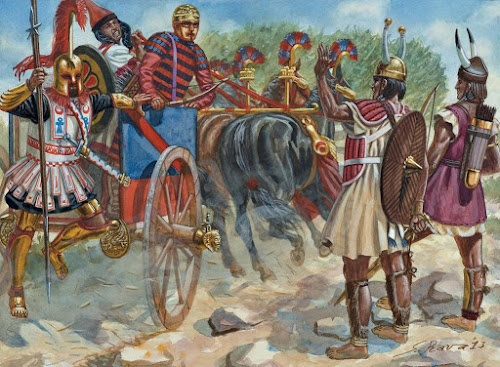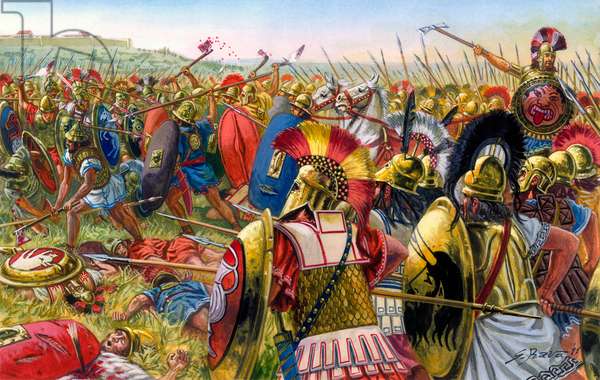1482 - Richard, Duke of Gloucester's Invasion Army
For a few months I have been painting up a MeG army for Richard, Duke of Gloucester's army which invaded Scotland in 1482. Having finished it, here it is for your perusal ...
This is actually the third time I have done this army. The first iteration started out as a Wars of the Roses Yorkist army way back in the days when I played DBM and then FoG:AM. When I started playing MeG a few years ago after a break from ancient/medieval wargaming I revisited the army. As I had by then found information on the English army led by Richard, Duke of Gloucester on behalf of his brother, King Edward IV, I persuaded the MeG "list-meister". Richard Jeffrey-Cook, to separate this army out from the Wars of the Roses lists and create an Edward IV list. This list also covers Edward's 1475 invasion of France, however, I decided to do the 1482 army that invaded Scotland.
This led to the second iteration of the army. As the figures I had were painted up in a variety of Yorkist livery colours it was really suitable for the 1482 army in my view as these wore white jakets with the cross of St. George on them as was usual for royal armies raised through indenture as opposed to those raised by the great lords for civil wars. Therefore, I sold the figures I had - not wanting to strip and repaint - and bought the army anew.
All was good until Khurasan Miniatures released a new Wars of the Roses range. These really caught my eye and looked to be somewhat better than the figures I now had. In fact, I'd say this is the best 15mm Wars of the Roses range currently available. So once again I sold the army I had and with the proceeds bought the figures for a new iteration.
That was back at the start of the year, and since then I have been painting the new figures off an on as the mood took me. After about 6 months of intermittent progress the army is now complete. I can't claim to be a great painter, but I am pretty pleased with how these have come out.
So here are the results of my work ...
First up the generals for the army. From left to right: Viscount Lovell, Richard, Duke of Gloucester, the Earl of Northumberland, and Lord Stanley. The banners and flags are from Donnington.
Next a couple of bases of what the army list call "Royal men-at-arms", which would be Richard's personal close retinue men-at-arms. Horse armour does not appear to have been common in England, probably partially because of the tradition of fighting mainly on foot, however, we know from the City of London import records that some was being brought into England in small quantities. Richard, being somewhat of a student of the changes in continental methods of warfare where horse armour was becoming common, is a good candidate to have troops equipped with such. I also painted up bases for use if and when they dismount. Flags were self made.
Next are the bulk of the mounted troops for the army. These do not have the horse armour for the reason noted above. During most of the previous 150 years or so these would normally fight on foot, however, the Wars of the Roses saw a bit more use of cavalry by the English and it was back in fashion on the continent (not that it ever went away in many places) and as mentioned Richard appear to have had an interest in modern military developments making cavalry use more likely. Their dismounted versions are pictured later. Banners were taken from an image found on line and tweaked a bit.
I painted up two units of men-at-arms on foot. One of these can be the dismounted versions of the cavalry above, with another unit for those who are fighting on foot from the start. These are some of the best troops in the army (as you'd expect) and will usually do some pretty heavy fighting. The St. George flag was self created - not exactly a difficult one to do after all.
Following these are two units of archers which can be used as the more experienced/effective archers in the army - one the army list calls "Retinue archers". To distinguish them from the other archers (see following pictures) these have a different banner style so that I can easily tell them apart on the table top and so avoid embarrassing errors. This banner came from somewhere on the internet ages ago - a bit lazy not to make one myself, but what the heck.
The majority of the archers are pretty much the same figures, but as noted they have a different (self made) banner. Pictures from the front and the rear so you can see the cross of St. George on the jakets. On the whole I haven't painted one on the front as the figures didn't really lend themselves to it. I also tried to get a bit of a "dirty/worn" look to the jakets - nothing to do with issues getting a good clean white, honest ...
Next we come to the non-English part of the army. Richard recruited a substantial number of foreign mercenaries for the campaign, probably at quite a cost. These were pikemen (Burgundians, Swiss and Germans are recorded) and handgunners - again, probably a result of Richard's interest in continental developments in warfare. The records show that these were issued with red (described as "rose") and white jakets as a "uniform". Overall, they may have made up 10% or so of the army. I have assumed that they would fight under English banners as mercenaries rather than troops supplied by a friendly power.
Lastly, every MeG army has a camp - or a base representing the camp, as an actual camp would be far larger than how we depict them in the game. This is mine. A useful way to use up spare figures.
I have not yet used this iteration of the army, but have played it previous with, shall we say, mixed results.
Here is a list I have used:





















brilliant paintwork as ever!
ReplyDeleteThe painting may not be the most advanced in the world, but it's quite effective!
ReplyDeleteGreat work, a lovely army!
ReplyDelete